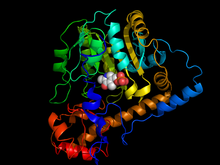Aspartate transaminase
| aspartate transaminase | |||||||||
|---|---|---|---|---|---|---|---|---|---|

Aspartate aminotransferase from Escherichia coli bound with cofactor pyridoxal 5-phosphate.
|
|||||||||
| Identifiers | |||||||||
| EC number | 2.6.1.1 | ||||||||
| CAS number | 9000-97-9 | ||||||||
| Databases | |||||||||
| IntEnz | IntEnz view | ||||||||
| BRENDA | BRENDA entry | ||||||||
| ExPASy | NiceZyme view | ||||||||
| KEGG | KEGG entry | ||||||||
| MetaCyc | metabolic pathway | ||||||||
| PRIAM | profile | ||||||||
| PDB structures | RCSB PDB PDBe PDBsum | ||||||||
| Gene Ontology | AmiGO / EGO | ||||||||
|
|||||||||
| Search | |
|---|---|
| PMC | articles |
| PubMed | articles |
| NCBI | proteins |
Aspartate transaminase (AST) or aspartate aminotransferase, also known as AspAT/ASAT/AAT or serum glutamic oxaloacetic transaminase (SGOT), is a pyridoxal phosphate (PLP)-dependent transaminase enzyme (EC 2.6.1.1) that was first described by Arthur Karmen and colleagues in 1954. AST catalyzes the reversible transfer of an α-amino group between aspartate and glutamate and, as such, is an important enzyme in amino acid metabolism. AST is found in the liver, heart, skeletal muscle, kidneys, brain, and red blood cells. Serum AST level, serum ALT (alanine transaminase) level, and their ratio (AST/ALT ratio) are commonly measured clinically as biomarkers for liver health. The tests are part of blood panels.
Aspartate transaminase catalyzes the interconversion of aspartate and α-ketoglutarate to oxaloacetate and glutamate.
Aspartate (Asp) + α-ketoglutarate ↔ oxaloacetate + glutamate (Glu)
As a prototypical transaminase, AST relies on PLP (Vitamin B6) as a cofactor to transfer the amino group from aspartate or glutamate to the corresponding ketoacid. In the process, the cofactor shuttles between PLP and the pyridoxamine phosphate (PMP) form. The amino group transfer catalyzed by this enzyme is crucial in both amino acid degradation and biosynthesis. In amino acid degradation, following the conversion of α-ketoglutarate to glutamate, glutamate subsequently undergoes oxidative deamination to form ammonium ions, which are excreted as urea. In the reverse reaction, aspartate may be synthesized from oxaloacetate, which is a key intermediate in the citric acid cycle.
...
Wikipedia
